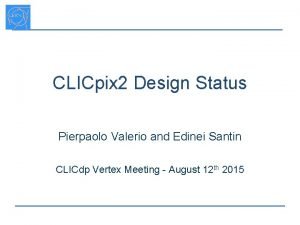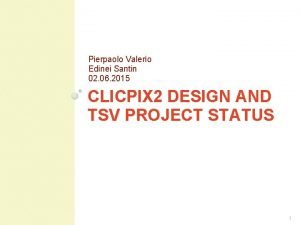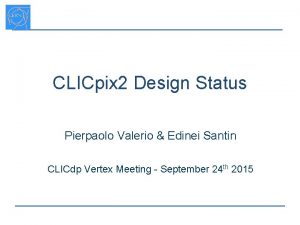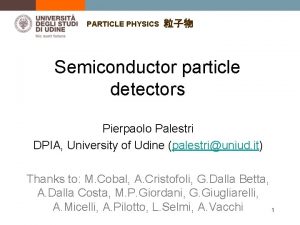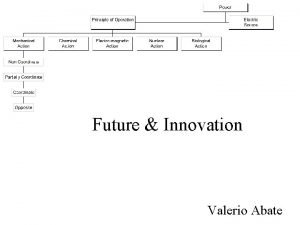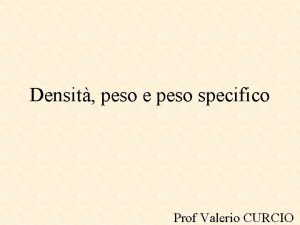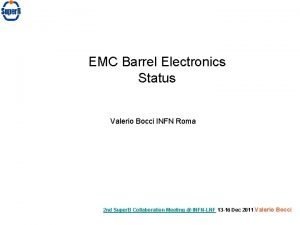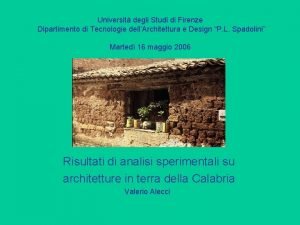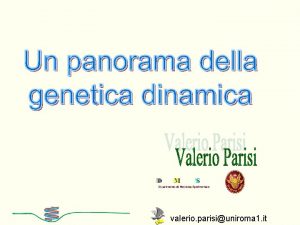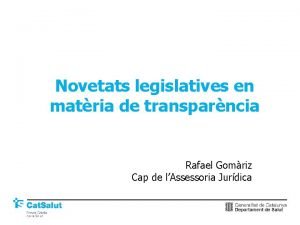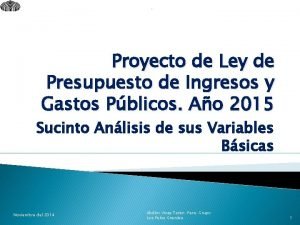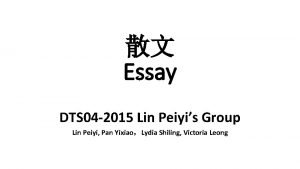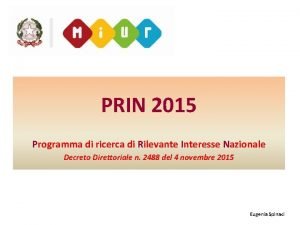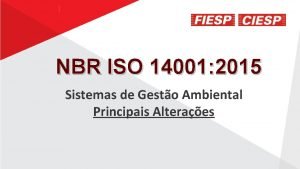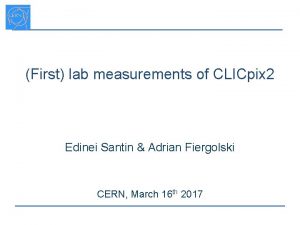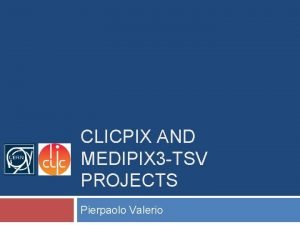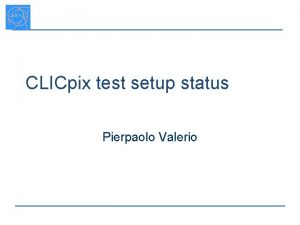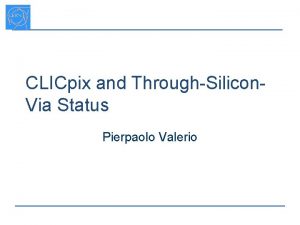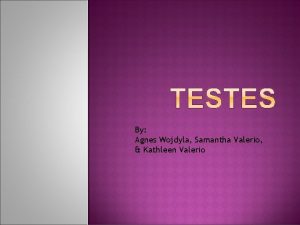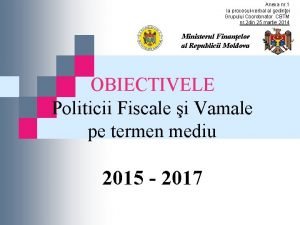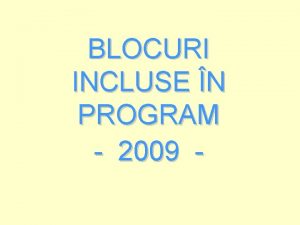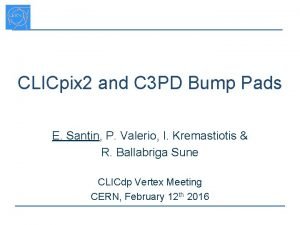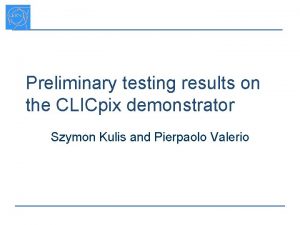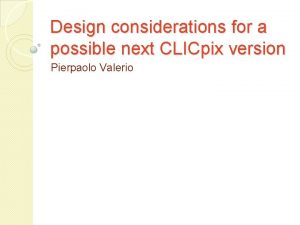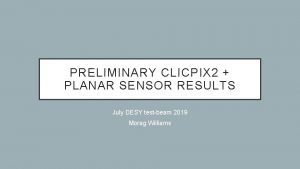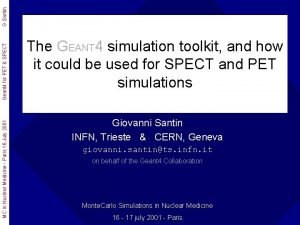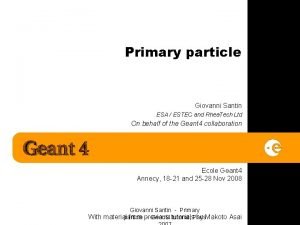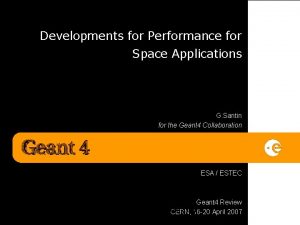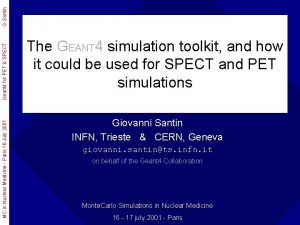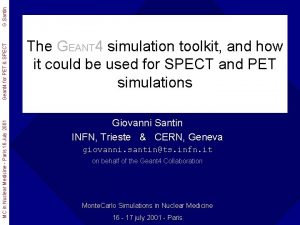Pierpaolo Valerio Edinei Santin 02 06 2015 CLICPIX




























- Slides: 28

Pierpaolo Valerio Edinei Santin 02. 06. 2015 CLICPIX 2 DESIGN AND TSV PROJECT STATUS 1

Outline CLICpix 2 ◦ Overview ◦ Analog part ◦ Digital part ◦ Status TSV project ◦ Status 2

CLICpix 2 Overview CLICpix 2 is a revised and improved version of the CLICpix prototype currently being designed Main improvements: ◦ Larger pixel matrix (64 x 64 128 x 128 pixels) ◦ Longer counters (8 bits To. A + 5 bits To. T) ◦ 13 bits To. A/counting with no To. T mode of operation ◦ Improve isolation of sensitive analog nodes ◦ Improve the communication logic ◦ Include a bandgap block Die photo 3

Work plan March April W 2 W 3 W 4 W 1 W 2 W 3 Comparator architecture comparison and evaluation (Throughout) simulation of the digital pixel with a new testbench Study of “large matrix” effects (power drops, biasing lines, signal delays…) Study of isolation possibilities (triple well? ) Update of end of column, periphery logic to accommodate larger matrix Layout of the analog pixel Extracted simulations of analog + digital to evaluate specs fulfilment Implement 8 to 10 encoding logic Writing a better digital testbench + digital simulations Band-gap IP simulation and implementation Final chip assembly and verification (+ safety margins) May June W 4 W 1 W 2 W 3 W 4 Different analog and digital tasks were identified and split between the design team The schedule is feasible, but we want to prioritize having a well verified design before submission There are submissions through IMEC every two weeks. Booking a run requires only a two-week notice. 4

Outline CLICpix 2 ◦ Overview ◦ Analog part ◦ Digital part ◦ Status TSV project ◦ Status 5

Analog frontend updates Feedback networks of the CSA were slightly downscaled to reduce their area CSA and calibration DAC topologies kept the same Study on the two-stage comparator topology pointed out that it has better gain-speed tradeoff than a three-stage one. Hence, we didn’t change its topology 6

Analog frontend layout 12 um 25 um Width is 2 um shorter than previous layout Substrate isolation with deep n-well Better physical separation of the building blocks 7

Substrate Isolation VSSA Dig ita An g alo Dig ita l l A isolated from VSSD with deep n-well Noise B propagation from noisy digital substrate to VSSA is highly attenuated 8

Floorplan comparison Before Now Better physical separation of the building blocks, which means less crass-talk among them due to routing 9

Pixels mirroring Right analog pixel of the double column Left analog pixel of the double column Left and right analog pixels are mirrored to ensure symmetrical routing, and also to enclose the deep n-well 10

Analog & Digital Power Distribution VSSD Y R A N I LIM E R P Ultra-thick 2 um VSSA 2 um 25 um 3. 5 um VDDA 2. 5 um VDDD metal (Rsh ≈ 5 mΩ/sq) used for power distribution Maximum IR drop on VDDA/VSSA is ~6 m. V for the pixels at the top of the matrix 11

Outline CLICpix 2 ◦ Overview ◦ Analog part ◦ Digital part ◦ Status TSV project ◦ Status 12

Updated pixel logic The logic has been updated and resynthesized It is slightly bigger than before: 200 by 25. 2 µm for a group of 16 pixels (it was 200 by 22. 4 µm before) The additional area takes the place of a more compact analog side layout 13

Updated pixel logic The counters now have increased depth: ◦ 5 bits To. T (up from 4) ◦ 8 bits To. A / event counting (up from 4) A new acquisition mode can be selected, combining the two counters as a single 13 bits To. A / event counting register with increased dynamic range A small readout bug has been solved, allowing a faster readout when the compression feature is enabled Overflow control is still applied to all the counters in all modes of operations 14

Readout logic The current readout architecture works as intended, but it’s difficult to use a fast clock with it due to synchronization issues In order to make it easier to design the DAQ board and firmware, it’s better to use a higher clock frequency with a clock recovery mechanism (8/10 bit encoding) Due to the lack of a PLL block, we will use the acquisition clock (100 MHz) as the input clock for control signals and have a second clock (≥ 320 MHz) only used for the readout command 15

Parallel readout In order to use clock Efficiency recovery for the readout, the chip needs to send data at a faster speed (≥ 640 # columns Mbit/s) Sending a very fast clock to the pixel matrix is not possible Occupanc due to the clock y distribution tree The chip can thus be configured to read multiple columns in parallel (using a slower clock) and serialize the data at the output The efficiency loss in terms of readout time is limited at the expected occupancies 16

Other readout blocks A 8 to 10 bit encoder is included in order to allow for clock recovery and AC coupling for the output A Double Data Rate (DDR) block will be implemented to limit the needed clock frequency. This way a 320 MHz clock is enough to output data at 640 Mbits/s A clock divider is used to have a slower clock to be distributed to the pixel matrix; the undivided clock is only used for the output serializer 17

Outline CLICpix 2 ◦ Overview ◦ Analog part ◦ Digital part ◦ Status TSV project ◦ Status 18

Current status Extracted simulations of the analog frontend are being carried out to verify specifications fulfillment The pixel logic has been fully synthesized, simulated and validated The digital periphery (command interpreter, power pulsing logic…) is mostly unchanged from the previous chip The readout logic is being designed and simulated but it has yet to be fully synthesized 19

Outline CLICpix 2 ◦ Overview ◦ Analog part ◦ Digital part ◦ Status TSV project ◦ Status 20

Medipix chips related TSV developments – Third run (3 D 06) Inputs from G. Pares (CEA LETI) and J. Alozy (CERN) Launched in CEA LETI (Grenoble) in July 2014 - Proof of concept of TSV last with TIMEPIX 3/Medipix 3 RX wafers thinned to ~ 50μm - Reuse the TSV bricks maturated with 3 D 01 (Medipix 3) and 3 D 05 (Medipix 3 RX) but adapted to such thickness Lot # D 14 S 0398 (Medipix 3 RX) started in July 2014: First lot has been processed using 2 Medipix 3 RX that is well known and its TSV compatibility has been proven ◦ P 01 -W 145 -AJPFVDH (TSV ᴓ 60 μm, depth 50 μm) ◦ P 02 -W 129 -ANPG 8 JH (TSV ᴓ 60 μm, depth 50 μm) ◦ +P 05 -W 127 -AKPGALH (rework from 3 D 05 120 μm thick) Lot# D 14 S 0705 (Timepix 3) started in September 2014: Second lot has been processed using only 2 Timepix 3, since limited number of Timepix 3 wafer candidates are available. First TSV trials using TIMEPIX 3 chip ◦ P 04 -W 006 -AIPW 0 DH (TSV ᴓ 60 μm, depth 50 μm) ◦ P 03 -W 007 -A 2 PVZDH (TSV ᴓ 60 μm, depth 50 μm)

Medipix chips related TSV developments – Third run (3 D 06) Lot # D 14 S 0398 (Medipix 3 RX): ◦ Front side Under Bump Metallization and thinning to ~50 μm have been done without problems ◦ There were some difficulties in the TSV fabrication, issues with arcing during Hard Mask etching. ◦ After Redistribution Layer Lithography process a visual inspection of the TSV was done and some residual polymers were discovered, probably generated between seed deposition and Lithography steps. ◦ Despite of all these issues the first electrical results are very good (daisy chain tests). A minor leakage current was observed but it is comparable to previous lots. ◦ Wafers have been sent out for debonding and dicing

Medipix chips related TSV developments – Third run (3 D 06) Lot # D 14 S 0705 (Timepix 3) : ◦ There are still issues with HM etching but a new recipe with lower power and higher pressure has been successfully tested at PMD etch limiting additional arcing during that process. ◦ The lot has been electrically tested (we wait for the test results from LETI) and sent to EGV (Austria) for debonding from temporary carrier and bonding on dicing tape. They are about to be received by DISCO (Germany) for dicing (dicing probably during the week of the 1 st June 2015). ◦ After dicing both lots will be returned to CEA LETI for inspection and ejection from dicing tape. ◦ Finally the diced chips will be returned to CERN for validation tests (before end of June)

THANKS FOR YOUR ATTENTION 24

BACKUP SLIDES 25

Pad geometry There is only a 2 14 um 8 um 12 um 10 um 22. 5 um um spacing between the opening and the edge of the pad, but the opening is big enough for electroplating An added aluminium “tail” can increase the capacitance to a HVCMOS sensor 26

Medipix chips related TSV developments – Third run (3 D 06) Lot # D 14 S 0705 (Timepix 3) : ◦ Some dimensions of the pixel pads are smaller than Medipix 3/3 RX. Making the front side UBM process more sensitive to misalignment. Due to that P 03 Litho has to be reworked. Final UBM pixel diameter =24 μm Before process SEM image: Better view of the final topology Post Litho After rework of Litho On this lot some residues of UBM etching remains at the edges of the wafer Post Etch

Medipix chips related TSV developments – Third run (3 D 06) Lot # D 14 S 0705 (Timepix 3) : Micro-Acoustic Inspection of the wafer bonding to its temporary carrier. No defects
 Clicpix
Clicpix Pierpaolo valerio
Pierpaolo valerio Pierpaolo valerio
Pierpaolo valerio Particle detector
Particle detector Valerio abate
Valerio abate Slidetodoc.com
Slidetodoc.com Kellee valerio
Kellee valerio Valerio curcio
Valerio curcio Valerio bocci
Valerio bocci Valerio alecci
Valerio alecci Valerio andreozzi
Valerio andreozzi Valerio bozza
Valerio bozza Valerio parisi genetica ed evoluzione
Valerio parisi genetica ed evoluzione Decret 171/2015
Decret 171/2015 Presupuesto 2015
Presupuesto 2015 Dse 2015 eng
Dse 2015 eng Nmx-j-549-ance
Nmx-j-549-ance Wpc 2015 dashboard
Wpc 2015 dashboard Dts group 2015
Dts group 2015 Sentinel device
Sentinel device Dpr 80 2013 sintesi
Dpr 80 2013 sintesi Lowes benefits 2015
Lowes benefits 2015 Prin 2015
Prin 2015 Nbr iso 14001 2015
Nbr iso 14001 2015 Gred spm 2015
Gred spm 2015 Netflix big data
Netflix big data Primerica convention registration
Primerica convention registration Teacher twins 2015
Teacher twins 2015 Begin schooljaar 2015
Begin schooljaar 2015
